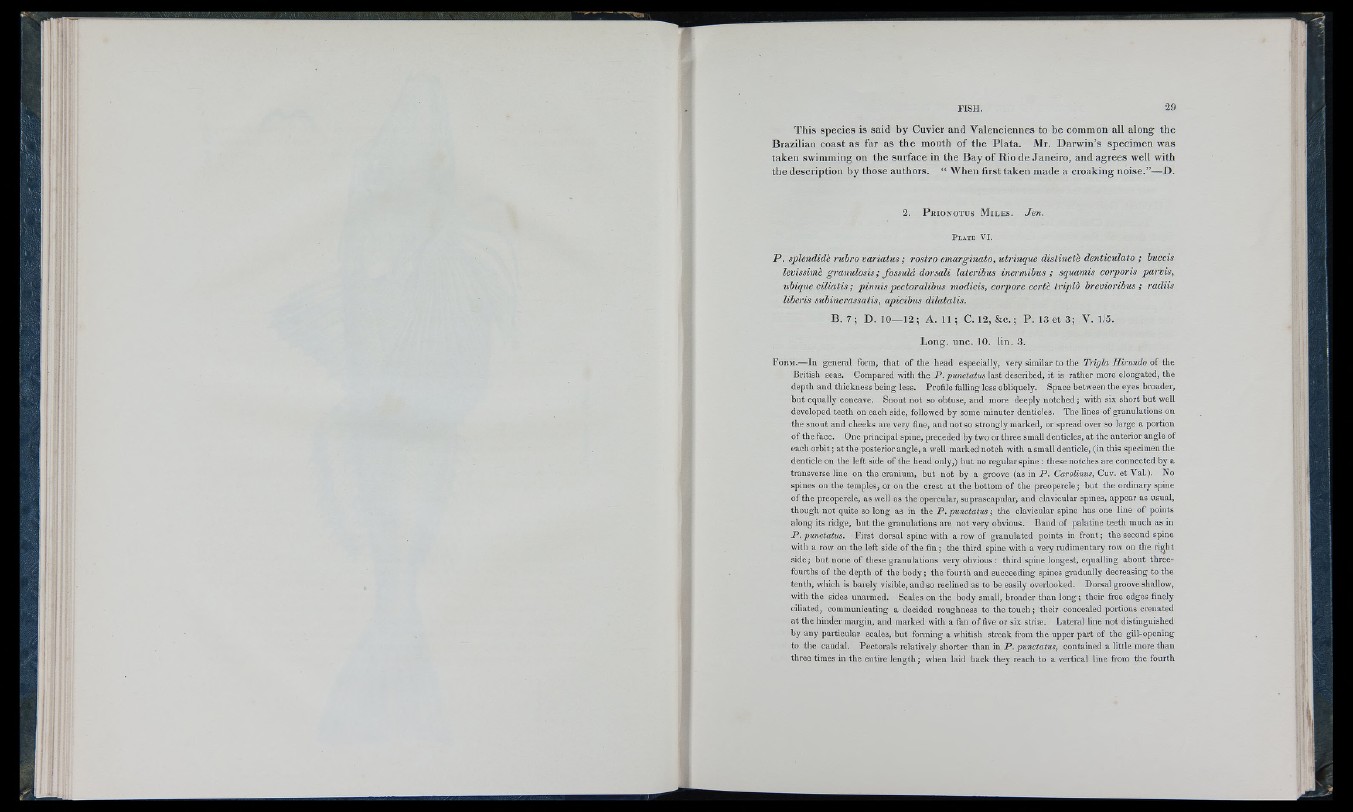
This species is said by Cuvier and Valenciennes to be common all along the
Brazilian coast as far as the mouth of the Plata. Mr. Darwin’s specimen was
taken swimming on the surface in the Bay of Rio de Janeiro, and agrees well with
the description by those authors. “ When first taken made a croaking noise.”—D.
2. P r io n o t u s M i l e s . Jen.
P . splendidh ruhro variatus ; rostro ernarginato, utriiyque distincth denticulato ; huccis
levissimh granulosis; fossula dorsali lateribus inermibus ; squamis corporis parvis,
ubique ciliatis; pinnis pectoralibus modicis, corpore certh tripld hrevioribus ; radiis
liberis suhincrassatis, apicibus dilatatis.
B. 7 ; D. 10— 12 ; A. 11 ; C. 12, & c.; P . 13 et 3; V. 1/5.
Long. unc. JO. lin. 3.
F o rm .— In general form, that of the head especially, very similar to the Trigla H irundo of the
British seas. Compared with the P . punctatus \a&i described, it is rather more elongated, the
depth and thickness being less. Profile falling less obliquely. Space between the eyes broader,
but equally concave. Snout not so obtuse, and more deeply notch ed ; with six short but well
developed teeth on each side, followed by some minuter denticles. The lines of granulations on
the snout and cheeks are very fine, and not so strongly marked, or spread over so large a portion
o f the face. One principal spine, preceded by two or three small denticles, at the anterior angle of
each o rb it; at the posterior angle, a well marked notch with a small denticle, (in this specimen the
denticle on the left side of the head only,) but no regular spine : these notches are connected by a
transverse line on the cranium, but not by a groove (as in P . Carolinus, Cuv. et Val.). No
spines on the temples, or on the crest at the bottom of the preopercle; but the ordinary spine
of the preopercle, as well as the opercular, suprascapular, and clavicular spines, appear as usual,
though not quite so long as in the P . punctatus ; the clavicular spine has one line of points
along its ridge, but the granulations are not very obvious. B and of palatine teeth m uch as in
P . puxictatus. F irst dorsal spine with a row of granulated points in fron t; the second spine
with a row on the left side of the fin ; the third spine with a very rudimentary row on the ri^ht
side; but none of these granulations very obvious: third spine longest, equalling about three-
fourths of the depth of the b od y ; the fourth and succeeding spines gradually decreasing to the
tenth, which is barely visible, and so reclined as to be easily overlooked. Dorsal groove shallow,
with the sides unarmed. Scales on the body small, broader than long; their free edges finely
ciliated, communicating a decided roughness to the to u ch ; their concealed portions crenated
at the hinder m argin, and marked with a fan of five or six stri®. Lateral line not distinguished
by any particular scales, but forming a whitish streak from the upper p art of the gill-opening
to the caudal. Pectorals relatively shorter than in P . punctatus, contained a little more than
three times in the entire length; when laid back they reach to a vertical line from the fourth